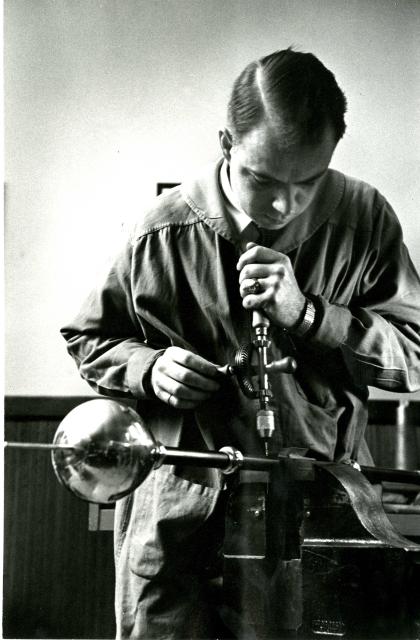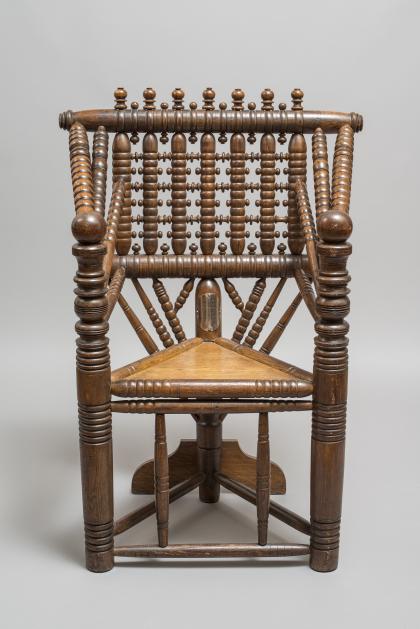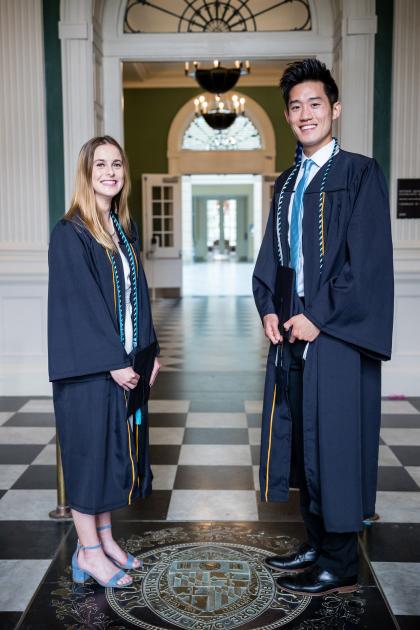Graduation ceremonies are rife with strange and antiquated customs, symbolic items and traditions such as the mortar board hats and tassels (whose roots go back to 11th century ecclesiastical caps) and colorful robes (thought to have begun as a practicality, as the ancient universities were drafty places).
As the pageantry of Commencement engulfs Johns Hopkins University this week, keep an eye out for these ritual objects.

Image caption: Baltimore silversmith Henry Powell Hopkins Jr. creating the JHU mace in 1953
Image credit: Johns Hopkins University Sheridan Libraries
The Mace
As Commencement chief marshal, Provost Ray Jayawardhana will lead the procession of dignitaries (JHU President Ron Daniels, the trustees, and the honorary degree recipients, among others) entering Homewood Field. He'll do so while brandishing the university's ceremonial mace, a 40-inch staff made of ebony decorated with sterling silver bands and topped with a pear-shaped silver sphere. The artifact, which also makes an appearance at Convocation, features imagery and symbols—Athena (goddess of wisdom), a bundle of books tied with a ribbon (a Chinese symbol of scholarship), the torch of knowledge—rendered in sterling silver, representing our cultural development from ancient times to the modern era.
Such maces were born out of the weapon of the same name, a fearsome battlefield bludgeon that's been around for thousands of years. Over time, the mace moved from being a deadly implement of war to a decorated symbol of power and authority wielded during royal, religious, and political ceremonies. Early universities made them part of their regalia as well. The University of Bologna's mace is thought to date to the 14th century, while the University of St. Andrews in Scotland has a 15th century model. Queen Elizabeth I gave a copy of her royal mace to the University of Oxford during her 16th century reign to serve as a symbol of her regal presence.
JHU's mace dates to 1954 when it was made by the appropriately named Baltimore silversmith Henry Powell Hopkins Jr. (thought to be a distant relative of the university's namesake). The maker's son, Henry Hopkins III, followed his father into the silversmithing business and says the family firm has gone on to make a dozen or so other maces, including for the Maryland Senate, the University of Pennsylvania, and Washington College. The university's carpentry department constructed a custom table to hold the mace during the ceremony.

Image caption: President Daniels wearing the Chain of Office at Commencement 2023
Image credit: Will Kirk / Johns Hopkins University
Chain of Office
This shiny bit of academic bling is worn by the university president, and it also has roots in the medieval era. Essentially, it's a large necklace of silver medallions engraved with the names and dates of service of past university presidents. Blank medallions are included for future leaders and the large center medallion bears the university seal. The symbolism is obvious: The wearer is part of an unbroken chain of leadership and authority. The same silversmiths who made the mace also made the chain. Actually, two of them: An initial version dates to 1966, and it was replaced with a model sporting larger medallions in 2020.

Image caption: The President's Chair, as shown in Evergreen: The Garrett Family, Collectors and Connoisseurs (Johns Hopkins University Press, 2015)
Image credit: Photography by Norman Barker and James T. VanRensselaer
The President's Chair
This curious, triangle-seated celebration of turned wood spends most of its days in the main hall of Evergreen Museum and Library. Once a year it is bundled up and brought to campus for the president of the university to sit on during Commencement. It is a replica of the president's chair used at Harvard and was a gift from the Harvard Club of Maryland in 1900 to mark the 25th anniversary of the inauguration of JHU's first president, Daniel Coit Gilman. Ira Remsen, the university's second president, was the first to perch upon it during Commencement. The original chair used at Harvard is believed to have been made in Britain some 450 years ago, but details are murky. No one knows how or where Edward Holyoke, Harvard's president from 1737 to 1769, acquired the piece, which is also known as the Holyoke Chair.
The Hopkins replica has some slight variations (an extra spindle or nob here and there) but is constructed using the antiquated methods of the original (no screws or other metal fasteners are employed). The padded triangular Naugahyde seat is of much newer vintage, and necessary as the tripod chairs have a reputation for being uncomfortable as well as a little unsteady. Indeed, both chairs have a stabilizing fin at the rear augmenting the three legs, as it wouldn't do to have the president pitch over amid the ceremonies.

Image caption: Newly minted alumni step on the JHU seal in Gilman Hall after the 2023 special Commencement ceremony for athletes
Image credit: Johns Hopkins University
Gilman Seal
This isn't part of Commencement ceremony per se, as this is a large university seal in the floor of Gilman Hall's foyer. But most probably know the legend surrounding it: Step on the seal as a prospective student and you won't be accepted. Current students whose feet contact the seal won't graduate, and faculty who walk across it won't get tenure. Many universities have similar seals and similar myths. It's not certain when JHU's began, though one theory suggests it was in the 1940s or '50s when Commencement was held on the steps of Gilman Hall, making it a quick and easy trip for graduates, sheepskin in hand, to saunter over and safely step on the seal. Some grads have even taken to dancing on it.
Learn more about JHU's Commencement regalia at the Our History page on the Commencement website.
Posted in Student Life
Tagged commencement 2024








